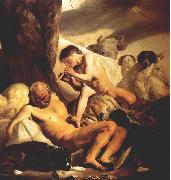Wholesale Oil Painting No Minimum |
|||||||||||
|
|
|||||||||||

|
|||||||||||
|
|
|
||||||||
CAMPEN, Jacob vanDutch Baroque Era Painter, 1595-1657 Chief exponent of Classicism in The Netherlands. He studied architecture in Italy and was influenced by the work of Scamozzi and Palladio. With his Coymans House on the Keizersgracht, Amsterdam (1624), he introduced the Palladian style to The Netherlands. His most refined work is the Mauritshuis in The Hague (1633?C5), which has a Palladian plan, elevations featuring a Giant Order of Ionic pilasters set on a plain base, a pedimented central section given little emphasis, and a hipped roof. Much grander is the Town Hall (now Royal Palace), Amsterdam (1648?C55): it has two internal courtyards separated by a huge central hall, façades with two superimposed Giant Orders of pilasters, and a large projecting pedimented central section over which is a domed lantern. His Nieuwe Kerk (New Church), Haarlem (1645?C9), is based on the quincunx plan (essentially a Greek cross within a square), with square Ionic crossing-piers and a groin-vault over the crossing. He was responsible for the Accijnshuis, Amsterdam (1638), the Noordeinde Palace, The Hague (1640), and, with others, the decorations of Post's Huis-den-Bosch, Maarssen, near Utrecht (c.1628). |
||||||||
|
|
||||||||
Mercury, Argus and Io
Mercury, Argus and Io Painting ID:: 5548 |
1630s
Oil on canvas
Mauritshuis, The Hague 1630s Oil on canvas Mauritshuis, The Hague |
|||||||
|
CONTACT US |

